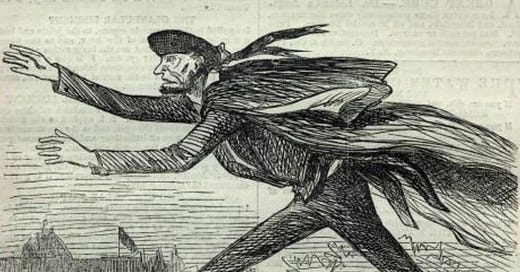TDIH: Plot against Lincoln
We all know about John Wilkes Booth's successful attack immediately after the Civil War, but do you know about the earlier threat to Lincoln?
On this day in 1861, President-elect Abraham Lincoln escapes a possible assassination attempt. We all know about John Wilkes Booth's successful attack immediately after the Civil War, but do you know about the earlier threat to Lincoln?
The months between Lincoln’s election and his inauguration were dicey. Seven states seceded from the Union following Lincoln’s election as President, and Lincoln began to receive many death threats. Moreover, just as Lincoln was preparing to travel to D.C. for his inauguration, Jefferson Davis was elected President of a new confederacy of southern states.
Nevertheless, Lincoln continued with his plans to travel to D.C. by train. His journey would take him 2,000 miles, and he planned to make frequent stops to see the public.
One of the railroad executives responsible for Lincoln’s trip became worried. He’d heard of a “deep-laid conspiracy to capture Washington, destroy all the avenues leading to it from the North, East, and West, and thus prevent the inauguration of Mr. Lincoln in the Capitol of the country.”
How easy it would be to attack Lincoln at this point! After all, the details of his scheduled train trip had been pretty well publicized.
The executive hired Allan Pinkerton, a detective from Chicago. Soon, Pinkerton and his agents were working to embed themselves in the city of Baltimore, pretending to be rabid secessionists. Not only was the city a hotbed of opposition, but it was also a critical stop on Lincoln’s train journey. Despite the short time frame, Pinkerton was successful in gaining the trust of a group of would-be assassins. He unearthed details of a plot to assassinate Lincoln and believed the President-elect was in danger.
Pinkerton later wrote: “A vast crowd would meet him at the Calvert street depot, at which point it was expected that he would enter an open carriage and ride nearly half a mile to the Washington depot. Here it was arranged that but a small force of policemen should be stationed, and as the President arrived a disturbance would be created which would attract the attention of these guardians of the peace, and this accomplished, it would be an easy task for a determined man to shoot the President, and, aided by his companions, succeed in making his escape.”
In the end, Lincoln secretly slipped out of Harrisburg on the night of February 22. He was disguised, and telegraph lines were cut to prevent the possibility of a communication to Baltimore. Lincoln took a secret route that covered 200 miles and involved two train switches—including one in the middle of the night in Baltimore.
That switch in Baltimore had to have been nerve-wracking. Lincoln arrived at one railroad station, but he needed to leave from another. Can you believe that a horse was needed to pull Lincoln’s train car through Baltimore streets from one rail station to the next?
But it worked. When Lincoln’s official train arrived in Baltimore on February 23, the President-elect was nowhere to be seen. He was already safely in Washington, D.C.
One New York paper reported on the scene: “As soon as the train stopped the crowd leaped upon the platforms and mounted to the tops of the cars like so many monkeys, until, like a hive of bees, they swarmed upon them, shouting, hallooing, and making all manner of noises.” Was that the riot meant to disguise Lincoln’s would-be assassin? Or was it just a raucous crowd?
We may never know.
Sources can always be found on my website, here.





Another interesting piece of history I was unaware had happened. It’s sad that the same precautions and protections weren’t taken when Lincoln was in fact assassinated. How different things could have been. One thing has become abundantly clear as you’ve posted accounts of our history. Tara, it was a rocky road building, maintaining and securing the foundation of the nation. Somehow, through perseverance and determination freedom loving patriots faced every challenge and so far we are still standing. Wonder for how long?
Today we learn that financing a crowd to be part of a subversive plot to wreak havoc on our nation is not a new thing. The struggle to maintain our Republic continues to this day.